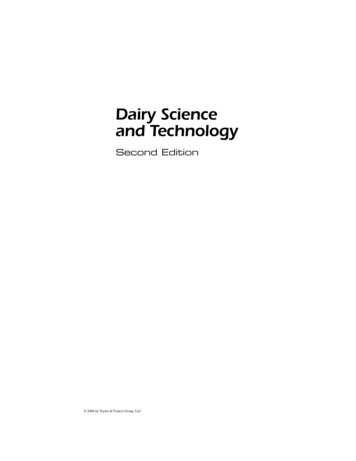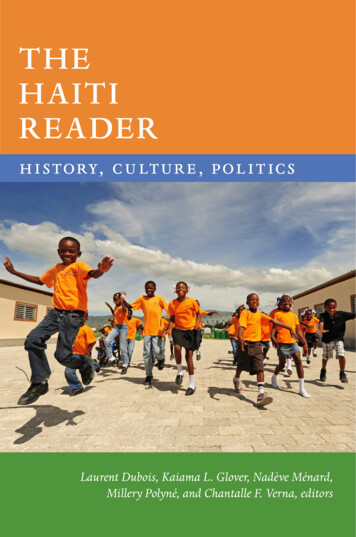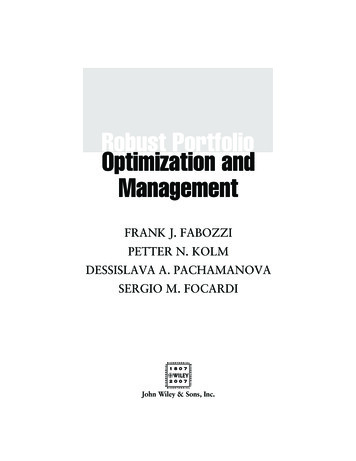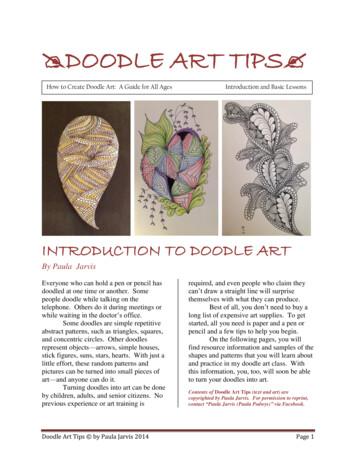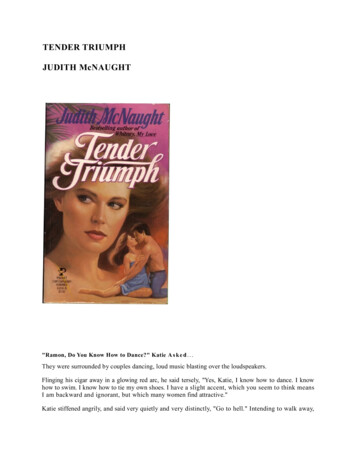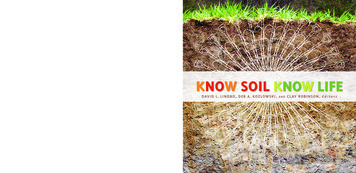
Transcription
Know Soil, Know Life will introduce you to an amazing world—the world beneathyour feet. Soil is the foundation our natural living world depends on, the oftenunappreciated substance of life, the dynamic material that civilization is builtupon, the critical zone of the earth. Soil is not dirt. Soil is life!who is this book for? High school students studying environmental science orparticipating in an Envirothon or Science Olympiad will find Know Soil, Know Lifeis an easily accessible resource. Undergraduate students in introductory ecologyclasses will have a manageable soils textbook. But this book is for all ages. Everyoneinterested in being more environmentally conscious—the urban dweller, the youngnaturalist, the home gardener—can find something of interest.and edited by leadingsoil science researchers,educators, and consultants.Edited byDavid L. LindboPh.D., CPSS, NCLSSNorth Carolina StateUniversity, Raleigh, NCDeb A. KozlowskiB.S.F., M.S.Woods Charter SchoolChapel Hill, NCClay RobinsonPh.D., CPSS, PGStetson Engineers Inc.Albuquerque, NM9 780891 189541Lindbo Kozlowski RobinsonWhat is there to learn about soils? You will see how an understanding ofbiology, chemistry, physics, and ecology will open your eyes to the complexityof the world underfoot and all life on Earth. You will learn the language that soilscientists use to communicate with each other. You will see that soils are different,dynamic, and constantly changing. When left alone soils are resilient, but as weuse them for our own purposes they can become fragile. Understanding soilshelps us make wise land-use decisions, whether we are managing public lands,agricultural lands, the construction of roads or buildings, waste managementefforts, wetlands and other water resources, or even our own backyards! Soilscience helps us to grow healthy food for the world. You will learn that soils dictatedthe rise and fall of ancient civilizations and have been a recurring theme in art andliterature. Soils are the foundation of life as we know it on Earth. It is in our own bestinterest—and the interest of humanity at large—to learn about soils and preservethis valuable resource. Know Soil, Know Life brings soils to life and invites readersto look at soils in new and exciting ways.Know Soil, Know Lifewas written, peer-reviewed,Know Soil Know LifeHow well do we really understand life on Earth? We know that all itscomplexity and diversity is necessary for our well-being. We know that life on Earthmakes us unique in the solar system. But, did you ever consider that with no soilthere would be no life?Know Soil Know LifeDav i d L . L i n d b o , D e b A . K oz lo w s k i ,andC l ay Ro b i n s o n , E d i t o r s
Copyright 2012 Soil Science Society of AmericaALL RIGHTS RESERVED. No part of this publication may be reproduced or transmittedin any form or by any means, electronic or mechanical, including photocopying,recording, or any information storage and retrieval system, without permission inwriting from the publisher.The views expressed in this publication represent those of the individual Editors andAuthors. These views do not necessarily reflect endorsement by the Publisher(s). Inaddition, trade names are sometimes mentioned in this publication. No endorsement ofthese products by the Publisher(s) is intended, nor is any criticism implied of similarproducts not mentioned.Soil Science Society of America5585 Guilford Road, Madison, WI 53711-5801 USA608-273-8080 BN: 978-0-89118-954-1 (print)ISBN: 978-0-89118-955-8 (electronic)doi:10.2136/2012.knowsoilLibrary of Congress Control Number: 2012954713ACSESS PublicationsISSN 2165-9834 (print)ISSN 2165-9842 (online)ASA, CSSA, and SSSA Book and Multimedia Publishing CommitteeApril Ulery, ChairWarren Dick, ASA Editor-in-ChiefE. Charles Brummer, CSSA Editor-in-ChiefAndrew Sharpley, SSSA Editor-in-ChiefMary Savin, ASA RepresentativeMike Casler, CSSA RepresentativeDavid Clay, SSSA RepresentativeLisa Al-Amoodi, Managing EditorivCover and interior design: Kristyn KalnesCover image: USDA-NRCSChristine Mlot, developmental editorJohn Lambert, custom illustrationsPrinted in the United States of America.
Know Soil Know LifeTo all our introductory soil science professors.You helped us see soilas something other than dirt.To all our students, past, present, and future,who we hope will come to view soil with awe and fascination.“Heaven is under our feet as well as over our heads.”Henry David Thoreauv
ContentsPreface, ixAcknowledgments, xAuthor Biographies, xiChapter 3SOIL BIOLOGY: THE LIVINGCOMPONENT OF SOIL, 49by Tom LoynachanChapter 1KNOW SOIL, KNOW LIFE, 1by David Lindbo, John Havlin, Deb Kozlowski,and Clay Robinsonsoil’s Importance to people, 1Soil’s importance in the Environment, 2How Much Soil is on Earth, 4What Is Soil, 6Basic Soil Processes, 6Soils and Biomes, 9Population Growth and Soil, 9Summary, 13Chapter 2Physical Propertiesof Soil and SoilFormation, 15by David Lindbo, Wale Adewunmi, and Rich HayesSoil Color, 15Soil Texture, 17Soil Structure, 24Soil Consistence, 26Soil Horizons and Profile, 27BULK DENSITY, 29WATER AND WATER MOVEMENT, 29DEPTH TO SEASONAL SATURATION, 31PERMEABILITY, 32INFILTRATION, 32SOIL ORGANIC MATTER, 32Soil Formation, 33SUMMARY, 45Organisms of the Soil, 51Life above the Soil Depends on Lifein the Soil, 57Soil Quality and Soil Management, 61Summary, 66Chapter 4Chemical Propertiesof Soil: Soil Fertilityand NutrientManagement, 69Chapter 6Environmental Science,Soil Conservation,and Land UseManagement, 109by Clay Robinson, Wale Adewunmi,David Lindbo, and Bianca Moebius-CluneNATURAL PROCESSES AFFECTING SOILDEGRADATION, 113Human Activities affecting Soildegradation, 128Summary, 136Chapter 7Soils and BioMes, 139by John Havlin and Bianca Moebius-Cluneby Clay Robinson, Wale Adewunmi,and David LindboNutrient supply to plants and NutrientCycling in soil, 70Nutrient Mobility in Soil, 72Soil Properties Influencing NutrientSupply to Plants, 73Assessing Nutrient Deficiency inPlants, 76Nutrient Management, 79Summary, 80Forests, 139Grasslands, 148Tundra, 152Deserts, 154Shrublands, 157Aquatic Biomes/Wetlands, 158Summary, 161Chapter 5Soil Classification,Soil Survey, andInterpretations ofSoil, 83by David Lindbo, Doug Malo, and Clay RobinsonSOIL CLASSIFICATION, 83Soil Surveys and Mapping, 92Interpretations, 97Summary, 105Chapter 8Soils and Society, 163by Melanie Szulczewski, Mandy Liesch,John Havlin, and David LindboSoils and Human Culture, 163Soils and Human Health, 168Challenges to the Soil: Then, Now,and Looking Ahead, 169Have we learned enough from pastmistakes? 179Summary, 181vii
Chapter 9Careers in SoilScience: Dig in, Makea Difference, 183by Susan Chapman and David LindboSo then, what does a Soil Scientist do? 184Who hires a soil scientist? 184What type of Education do you need? 184Do I need a certification or a licenseto be a Soil Scientist?, 185A Series of Adventures!Lisa “dirtgirl” Bryant, 186A lifelong scientist!Bill Shuster, 188My Diverse Life as a Soil Scientist.Dawn Ferris, 190Never Stop Learning!Missy Holzer, 192Enjoy the Challenge!Matthew “Matt” Duncan, 194Solving Problems, Reclaiming Land.Bruce Buchanan, 196Chapter 10Summary andPerspectives, 199by David Lindbo and Deb Kozlowskiviii
P r EFA C EYou are about to begin a tour of an often overlooked part of our natural world—thesoil. True, it does not have the immediate appeal of the cute, cuddly creatures thatlive in the forests or the power of a volcano or the vastness of space, yet soils have an innerbeauty of their own. This book will expose you to the nature of soils and soil science. Youwill see that the stuff you probably call dirt (and please do not use that word again!) isjust as complicated, interesting, and varied as any other part of our world. We have distilled a complex science down to about 200 pages. This writing is geared towards a youngadult audience. High school students studying environmental science or participating inEnvirothon or Science Olympiad will have an easily accessible resource. Undergraduatestudents in introductory ecology classes will have a manageable soils textbook. However,this book’s information is for all ages. See it as an appetizer, a teaser, or an advertisementfor soils. Everyone from the young naturalist to the home gardener can find something ofinterest in these pages. This book is your gateway to soils, soil science, and the world youtread upon every day.Studying soils makes you better able to understand the world around you; soil science istruly an applied science. You will see how an understanding of biology, chemistry, physics,and ecology will open your eyes to the complexity of the world underfoot. You will learnthe language that soil scientists use to communicate with each other. You will see that soilsare dynamic and constantly changing. When left alone soils are resilient, but as we use themfor our own purposes they can be fragile. It is in our own best interest and the interest ofour human civilization to preserve them. Soils are classified in ways to help us make wiseland use decisions as our population grows. Soils feed the world and will continue to do so.They dictated the rise and fall of ancient civilizations; have figured in art from the classicsto the post-modernist, in warfare, and in literature. But soils are more than that; they are thefoundation of life as we know it on Earth.Co-editorsDavid L. Lindbo, Ph.D., CPSS, NCLSSNorth Carolina State University, Raleigh, NCDeb A. Kozlowski, B.S.F., M.S.Woods Charter School, Chapel Hill, NCClay Robinson, Ph.D., CPSS, PGStetson Engineers Inc., Albuquerque, NMix
Ack n o w l e d g m e n t sSoil Science Society of America (SSSA) wishes to acknowledge and thank the Bureau ofLand Management for funding and support of the development of this publication aspart of their outreach activities to increase public awareness of our soil resources and promote responsible practices that reduce impacts to natural resources resulting from use ofpublic lands.SSSA is an international scientific society that fosters the transfer of knowledge and practices to sustain global soils. SSSA is the professional home for 6,000 members dedicated toadvancing the field of soil science. It provides information about soils in relation to environmental quality, ecosystem sustainability, bioremediation, waste management and recycling,crop production, and wise land use. A common thread across the programs and services ofSSSA is the dissemination and transfer of scientific knowledge to advance the profession.SSSA is also focused on outreach to students, teachers, and the public to tell the story ofsoil and build greater awareness of the value of soil to life. Visit our outreach www.iheartsoil.orgSSSA K-12 CommitteeChair: Clay Robinson; Members: J. Adewale Adewunmi, Suzanne Belflower, MeghanBuckley, Dedrick Davis, Jacob Elder, Sherry Fulk-Bringman, John Havlin, Margaret Holzer,Julie Howe, Amanda Mae Liesch, David Lindbo, Thomas Loynachan, Bradley Miller,Jarrod Miller, Bianca Moebius-Clune, Peter Narby, Robert Pesek, Susan Schultz,Melanie Szulczewski, Wendy Weitkamp;Ex Officio Members: Susan Chapman, Emily Fugerx
xviii
CHAPTER1KNOW SOIL, KNOW LIFEThe world around us is teaming withlife. We see it every day. We studyit in school so we can fully appreciate and know something about the naturalliving world around us. But how deeplydo we really know life? We know that itis necessary in all its complexities and diversity for our well being. We know thatlife on Earth makes us unique in the solarsystem. But rarely do we ponder the fundamental connection between soil and life.Do we ever consider that with no soil therewould be no life?This book will introduce you to anamazing world—the world beneath yourfeet. Soil is the foundation our naturalliving world depends on, the often-unappreciated substance of life, the dynamicmaterial that civilization is built on, thecritical zone of the earth. Once you know soilin its complexity and beauty, you will knowlife with broader horizons. You will seethat “heaven is under your feet as well asover your heads,” in the words of HenryDavid Thoreau. Soil is not dirt. Soil is life!This chapter highlights the importanceof soil to our everyday lives and introduces some basic facts about soil that will beexplored in depth in this book.SOIL’S IMPORTANCETO PEOPLEAs you consider the world around you,it comes as little surprise that everythingdepends on a few basic things: food, aplace to live, and water. In the bigger picture, energy is critical, the ultimate sourceof which is the sun.People have a few other particularneeds. We need air for oxygen, as well asfiber for clothing. Upon further consideration it may come as a surprise that muchof what we depend on—food, water, fiber,shelter—are all related to a single, oftenoverlooked item. This is soil! Soil (the pedosphere) represents the critical zone of theearth where life (the biosphere), water (thehydrosphere), minerals (the lithosphere), andair (the atmosphere) intersect and interact(see figure 1–1). We are reminded that toknow soil is to know life, and that with nosoil there is no life.A close look at what you ate for breakfast illustrates this point. You may havehad cereal, milk, and orange juice, or maybe toast. Where did each of these itemscome from? The wheat in your cereal orflour in your toast started out as plantChapter AuthorsDAVID LINDBOJOHN HAVLINDEB KOZLOWSKICLAY ROBINSONseeds. The milk came from a cow that ategrass. The juice came from oranges thatgrew on a tree. If you ate sausage or baconremember that meat comes from animalsthat are fed grain and forage, which alsocome from plants. So all your breakfastfoods, and food in general, can be traced toplants. But think about where plants comefrom: plants grow in soil! The soil provideswater as well as the nutrients plants needto produce the food we eat. When you eat,you are eating soil, although several stepsremoved. We rely on plants to supply uswith the food we need to survive. Withoutsoil to produce the plants we would haveno grains, no bread, no cereal, no milk,no meat, no fruit, no pizza, and thereforewould not be able to survive (figure 1–2).Next, consider your clothes. Your t-shirtand jeans are probably made of cotton—aplant that depends on soil. Other natural1
fibers like wool, linen, andsilk are also directly relatedGasesSoil airCO2to plants—wool comes fromOrganic matterO2animals that eat plants,Soil waterN2Soil particlelinen from flax plants, andsilk from silk worms thateat plants. Even many synthetic fibers can be related to soil.BiosphereRayon is a synthetic fiber madePlants, animals,microbes &from cellulose, which come frombyproductstrees and other plants. Othersynthetic fibers such as polyester are derived from fossil fuels.LithosphereHydrosphereFossil fuels are ancient plant andMinerals inWater & dissolvedanimalremains that have underrock & sedimentsubstancesgone extreme changes deep in theearth but nonetheless needed soil(or nutrients from soils and weathering) when they were living. Through a fewFigure 1–1. The intersecting spheres onsteps we can indeed link fossil fuels to soil.Earth: rock, life, air, water, and soil.AtmospherePedosphereFinally, think about the home you live in.In general, houses are made from lumberand bricks. It is easy to see that bricks areconnected to the soil, since they are madefrom clay and sand. Lumber takes a fewmore steps to connect to soil: lumber iswood; wood comes from trees; and trees,like other plants, need soil to survive as wesaw above. Very simply, your house as youknow it would not exist without soil.SOIL’S IMPORTANCE INTHE ENVIRONMENTWe’ve seen that soil is critical to ourfood, fiber, and shelter. It also plays animportant role in the cycling of anotheressential item: water. The amount of water on Earth is constant--there is no lossor gain of it. And only a small portion ofc)b)a)Figure 1–2. (a) Everything in this2shopping cart comes from soil. (b) Sodhouse, stick built house, green earthhouse—all from soil. (c) Clothed in mudor elegant dress—all from soil. Read thelabel on your shirt and think about howthe textile comes from soil. Cotton?Silk? Polyester? Rayon? Wool?
All waterLakes, 0.07%Groundwater, 0.93%Surface waterOther Fresh, 2.5%Soil moisture, 3.52%Swamps and marshes, 2.53%All fresh waterLakes,20.1%Surface and other, 1.3%Rivers, 0.46%Biological water, 0.22Atmospheric, 0.22%%Ocean (saline), 96.5%Groundwater,30.1%Ice and snow, 73.1%a)Figure 1–3. (a) Where is the wateron Earth? Soil treats all groundwater.(b) Water in the environment is filteredby soil. (c) Wastewater filtration uses soil,as in this septic system. (d) Wastewater isused in spray irrigation.Glaciers andice caps, StreamGroundwaterTreatmentin soilGroundwaterthat finite amount (approximately 1%) ofwater is usable for drinking (figure 1–3).How does this water remain clean enoughfor us to drink? You might think it’s because we treat it before we drink it. Whilethis is true in many urban or suburbanareas, many people worldwide get theirdrinking water from groundwater. Thisgroundwater is often not treated beforepeople drink it. Instead, it is treated bythe soil. As water infiltrates and percolatesthrough soil, the soil’s chemical, biological,and physical properties clean the water byremoving contaminants. This means thatsoil is perhaps the largest single water(and wastewater) treatment plant in theworld. Soil helps keep water clean by filtering it. We’ll learn more about the role ofsoil in water cycling in chapter 2.We’ve seen how soils are essential toplants, by providing many of the nutrients that plants need. Where the supply ofnutrients is too low for crops to grow weadd nutrients to ensure growth and a reliable food supply. Soils store the nutrientsuntil the plant needs them. Soil acts as anutrient reservoir for plant growth andsurvival. Soil also provides critical support for plant roots, preventing the plantfrom falling down or washing away. Soilalso acts as a sponge to hold water. Plantroots take up water, allowing the plant togrow and photosynthesize.3
In addition to its environmental rolesrelating to food and water, soil also playsa role in construction. Properties of soilare important to consider when constructing roads and buildings that will last. Inparticular some soils will shrink and swellbecause of changes in the amount of water present (figure 1–4). Engineers mustidentify these and other soil properties toproperly design structures (figure 1–4).Beyond our food, fiber, and shelter,soils are intimately involved in construction and water treatment. Now that weunderstand how important soil is to ourlives, we can consider how much of thisprecious resource we have.HOW MUCH SOIL ISON EARTH?Surprisingly, there is not that muchsoil on Earth, yet it is one of the most important natural resources. As the worldpopulation increases, the finite soil resource must provide enough food, fiber,and shelter for the world.Relatively speaking, how much productive soil do we have?The earth has approximately 149 million square kilometers (58 million squaremiles) of land area (figure 1–5). Of this,deserts and ice sheets account for about31% and forests another 31%. The remaining 38% is considered agricultural land,Figure 1–4. (a) Houses and roads are damaged when soils shrink and swell.(b) Buildings in permafrost can shift when the soils thaw and refreeze. (c) Roadconstruction sometimes involves bringing in sand and removing poor local soil.(d) Interceptor drains are used to divert water from foundations. (e) Constructionon organic soils requires special engineering to ensure stability. (f) Septicsystems in mounds are used to avoid high water tables.a)but 26% is in permanent pasture, usedonly to produce feed for livestock, suchas cattle, sheep, and goats. Only about12% of Earth’s land surface is used toproduce food and fiber (cotton) for human consumption. Of that, just over 1% isperennial cropland primarily used for orchards and vineyards. The remaining 11%is considered arable land, which is capableof sustaining annual crops. In the UnitedStates, about 23% of the land is in desertsor mountain ranges, 33% is in forests, 26%is rangeland used for grazing, and 18% ofthe land is used for producing crops.Since 1961 the global amount of landin annual crops has varied between 9.5%and 11%. In the same period, the worldd)c)e)b)4f)
ArableDeserts18.7%27.9 million sq km10.7%15.9 million sq kmPerennial crop1.2%1.8 million sq kmIce sheets12.6%18.8 million sq kmPermanent pasture25.8%38.4 million sq kmForest31.1%46.3 million sq kmFigure 1–5. Comparison of total area on Earth in various land uses.average of arable land per person has decreased from 0.37 hectares per person in1961 to 0.20 hectares in 2012. (Note thata hectare, or 10,000 square meters, is approximately 2.5 acres, and one acre is43,560 square feet). Nor is the arable landevenly distributed. In East Asia and thePacific, less than 0.10 hectare per person isavailable, while Africa has about 0.20 hectares and North America has about 0.61hectares. As the human population grows,arable land comes under increasing pressure to produce more food per hectare.Some countries don’t have the economicstrength to buy fertilizers, better seed, andother inputs required to increase yields,or they lack the means or water supply toirrigate, so they look for more land to produce crops. But converting other land intofood production poses problems.Many of the world’s forests are in areasthat are too cold to produce food crops.Others are in steep areas or shallow soilsover bedrock. Removing the trees fromthese soils leads to rapid erosion and loss ofproductivity. Other forests are in high rainfall regions with acid soils requiring manyamendments and careful managementto maintain productivity. The capital topurchase the inputs and management expertise in some of these regions is limited.Deserts are fragile ecosystems thatreceive too little precipitation to growcrops. Grazing lands (permanent pasture) are often in semiarid regions, andare highly susceptible to drought. Plowing such lands to produce food alreadyled to one Dust Bowl in North Americain the 1930s (see chapters 6 and 8) and ishaving similar impacts in Asia and Africanow. Some soils in deserts and semiaridregions have so much salt in them thatplant growth is limited.Irrigation can increase crop yields anddecrease drought risk for crop productionin arid and semiarid regions. However,water supplies are becoming more limiting in both quantity and quality. Overall,less than 1% of the arable land in the worldis irrigated. About 5.5% of arable land inthe United States is irrigated, while morethan 50% of the arable land in Pakistan,South Korea, and Bangladesh is irrigated.Worldwide approximately 40% of all foodcrops are irrigated.Medieval alchemists considered thereto be four elements: earth, air, fire, andwater. You can think of these as soil, air,sunlight, and water (figure 1–6), the fouritems critical to life on Earth. We know wecannot spin gold out of the four medievalelements, but we do need these four thingsto support something more valuable: alllife as we know it.Earth as an AppleGrasping land in terms of acres, hectares, square miles, or square kilometers may behard to fully comprehend. Another way to consider the relative amount of arable land isto imagine Earth as an apple. Cut the apple into four equal parts and discard three parts(75%)—that represents the oceans of the world. The fourth part (25%) represents the landarea. Cut the “land area” part in half, leaving two parts each equal to one eighth (12.5%) ofthe total apple. Discard one of the parts as it represents the deserts, wetlands, and polarareas where people do not live.The remaining part (12.5%) represents the areas where people live, but not all of it is usedfor producing food. Cut this remaining part (12.5%) into four pieces. Each remaining slicerepresents about one thirty-second (1/32, or 3.125%) of the original apple. Three of theseone thirty-second sections represent areas of the world that are too rocky, too wet, too hot,or where soils are too poor for growing food, as well as urban areas. Thus, only one thinslice of apple (3.125%) is suitable for food production. But also consider this: soil is presentonly at the very surface of the earth, so peel that last slice. The thin apple peelrepresents the soil where all our food, fiber, and shelter come from.Each year more and more of that thin sliver is lost from production,yet the human population continues to grow (see the endof this chapter and chapter 6). This makes it more andmore important to take proper care of the soil we have.5
Figure 1–6. A modern view of the alchemists’ four elements we cannot live without.WHAT IS SOIL?6Realizing the importance of soil andhow little there is, we need to briefly makesure we all know what soil is (figure 1–7).First and foremost, soil is not dirt. Dirt isthe stuff under your fingernails; it is whatyou sweep up off the floor; it is unwantedand unnecessary. Soil, on the other hand,is essential for life, so soil is not dirt! Dirtmay be soil out of place, just as a weed isa plant out of place. For example, a rosein a cornfield, while beautiful, is a weed; acorn plant in a rose garden is also a weed.So when you track mud (wet soil) inside,you are putting the soil in a place it is notwanted. At that point it becomes dirt.If soil is not dirt what is it? There areseveral definitions. Perhaps the simplestis that soil is a living, dynamic resource atthe surface of the earth. To expand thatdefinition, soil isa natural, three-dimensional body at theEarth’s surface. It is capable of supportingplants and has properties resulting fromthe effects of climate and living matteracting on earthy parent material, as conditioned by relief and by the passage of time.Worldwide tens of thousands of different soils occur on every continent andvirtually anywhere plant life can set roots.An understanding of the environment requires an understanding of soil—what it is,how it is formed, what it is made of, andhow it is used. Soil serves as a repositoryof many geological and climatic events thathave occurred in its location. It is a windowto the past, but it can also serve as a view ofthe future as its properties relate to how wecan and should manage this finite resource.Now consider a handful of soil. At firstit may seem lifeless and solid, but in reality soils are teaming with life and containpockets of air and water. There are fourcomponents to every soil: minerals, organicmatter (living and dead), water, and air.The minerals and organic matter make upthe solid phase. The water and air makeup the pore space. A typical handful of soilcontains 50% pore space, 45–50% mineralsand 0–5% organic matter (figure 1–8). Thesecomponents will be discussed in detail inthe next chapter. Soil as a whole is affectedby four basic processes, discussed next.BASIC SOIL PROCESSESThat same handful of soil is dynamicand responds to its environment. A greatnumber of processes take place in the soil,but they can be grouped together underfour major categories: additions, losses,transformations, and translocations (figure1–9). Each of these is briefly defined in thefollowing paragraphs.
Figure 1–7. What is the difference between soil and non-soil? Non-soilincludes dirt on the floor, sand dunes in deep desert, barren rock areas,and surface materials at extreme elevations. Think about where the soilis in the world around you—in an agricultural field, lawns, parks, andgardens in urban areas, as in New York’s Central Park. There is evensoil in the Artic and Antarctic desert, subaqueous soil with eel grassand seaweed, and where trees appear to grow straight out of rock.7
Organicmatter0-5%Minerals45-50%Pores50%Figure 1–8. Percentages of each compo-nent of soil: mineral, pore space (filled withair and/or water), and organic matter.Additions are easy to understand. Theyconsist of materials deposited on the soilfrom above, as well as materials moved inwith groundwater, such as salts. Obviousexamples are additions of leaf litter as treesshed their leaves, or additions of organicmaterial as plants and plant roots die. Alsoobvious are additions of mineral materialfrom flooding, landslides, and other geologic events. Perhaps not so obvious is thenearly constant addition of atmosphericdust to the soil surface. Some of this dustcan travel long distances and is importantto the overall fertility of a region. Rainfallis also an addition.Losses are also rather obvious. Erosionis a major form of soil loss. Loss can alsooccur as nutrients are taken up by plants,Figure 1–9. The four essential processes of soil: additions, losses, translocations, andtransformations.Across the Seas8One of Africa’s biggest “exports” is soil from theSahara Desert. Whipped up by winds and carriedinto the atmosphere, fine particles of desert soil cantravel across the entire Atlantic Ocean. The dustsometimes causes hazy skies in the southeasternUnited States and is even credited with adding needed nutrients to the soils of the Amazon rainforests.
m here!EXITINWelcome!Bon Voyage!Figure 1–10. Illuviation and eluviation can be understood with these metaphors—the first letter of these words will help you remember!Eluviation is like emigration, leaving your country or origin to go to a new country. Illuviation is like immigration into a new country. Exit is leavinga room, as eluviation is material exiting the horizon. In is moving into a new room, as illuviation is material moving into a zone below.and plants are harvested and removed.As minerals and nutrients move throughsoil into groundwater or out of the plants’rooting zone, this too is considered a loss.Tran
Soil BioloGy: the Living Component of soiL, 49 by Tom Loynachan orGanisms of the soil, 51 life aBove the soil depends on life in the soil, 57 soil Quality and soil manaGement, 61 summary, 66 Chapter 4 ChemiCal propertieS of Soil: soiL feRtiLity anD nutRient management, 69 by John Havlin a

